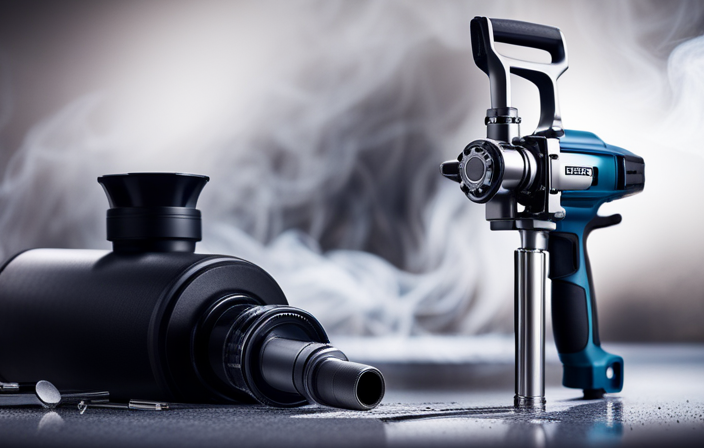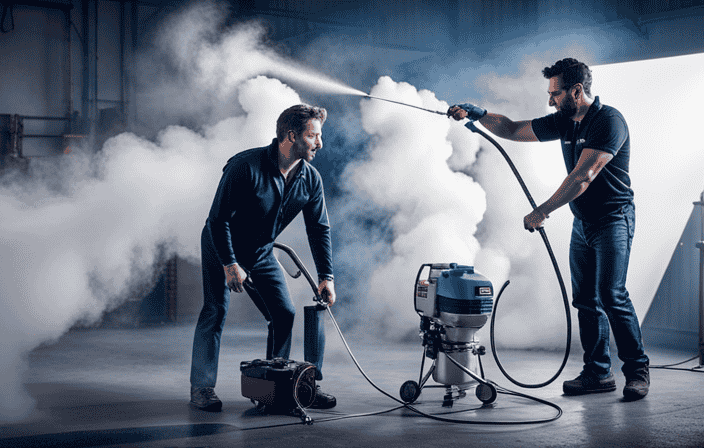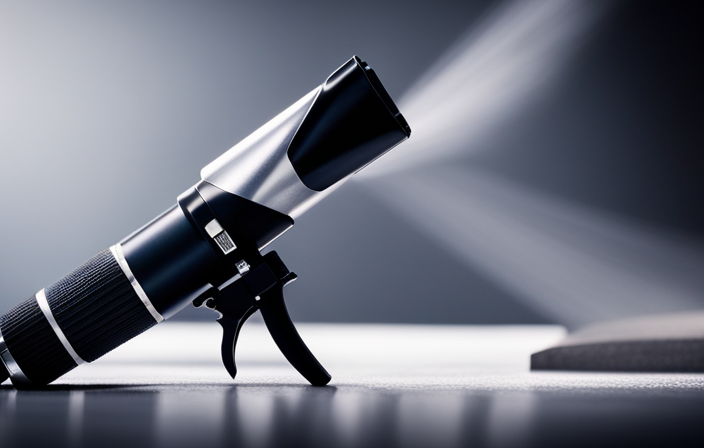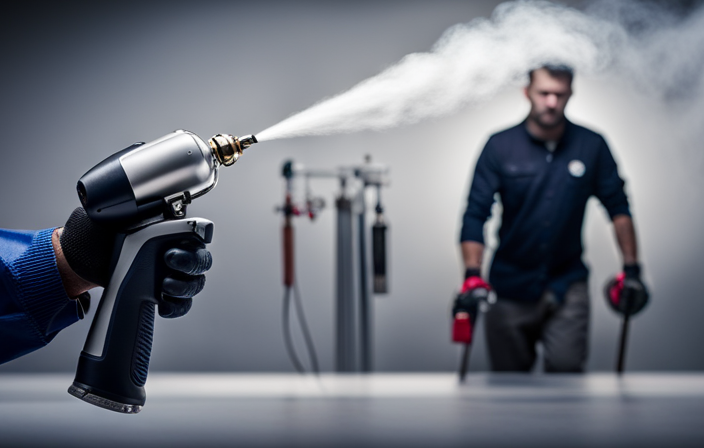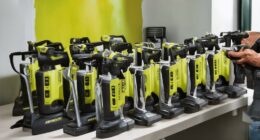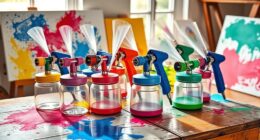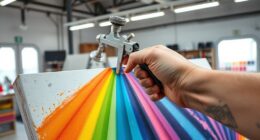Taking care of your Magnum True Airless Paint Sprayer might seem daunting at first, but have no fear! I am here to guide you through each phase of the cleaning routine. Just a little effort and the appropriate cleaning supplies will have your paint sprayer looking pristine and performing like it’s brand new in no time.
First, gather your cleaning supplies. You’ll need a bucket of warm water, a cleaning brush, a wrench, and some mild detergent. Once you have everything ready, disconnect and empty the sprayer, making sure to remove any leftover paint or debris.
Next, it’s time to remove and clean the nozzle. This is a crucial step as any clogs or buildup can affect the sprayer’s performance. Take your cleaning brush and gently scrub the nozzle to remove any paint residue.
After that, don’t forget to clean the filter. This ensures that any impurities are removed from the paint before it reaches the sprayer. Use warm soapy water to clean the filter thoroughly.
Now it’s time to flush the system. This involves running clean water through the sprayer to remove any remaining paint or cleaning solution. Make sure to flush all the hoses and tubes as well.
Once you’ve completed these steps, reassemble the spray gun and attachments. Test the sprayer to ensure it’s working properly before storing it away.
Cleaning your Magnum True Airless Paint Sprayer doesn’t have to be a daunting task. By following these steps, you’ll be able to maintain the performance and longevity of your sprayer, allowing you to achieve professional-quality paint jobs every time.
Key Takeaways
- The cleaning process for a Magnum True Airless paint sprayer involves disassembling the spray gun, cleaning the nozzle and filter, and lubricating the moving parts.
- It is important to pay attention to small crevices and intricate parts when cleaning the spray gun, and to use a brush or toothpick to dislodge stubborn residue.
- The hoses and tubes of the sprayer should be disconnected and gently scrubbed, then rinsed thoroughly with clean water and allowed to dry.
- When reassembling the spray gun, it is crucial to attach the nozzle tip securely, align the filter and guard assembly correctly, and insert the paint suction tube properly.
Gather Your Cleaning Supplies
Now that you’ve gathered all of your cleaning supplies, it’s time to dive into the process of cleaning your Magnum True Airless Paint Sprayer. Cleaning supplies are essential for ensuring a thorough and effective cleaning process. You’ll need a cleaning solution specifically designed for paint sprayers, such as a paint thinner or mineral spirits. Additionally, grab a bucket, a cleaning brush with stiff bristles, and some clean rags.
When it comes to cleaning techniques, start by disconnecting the sprayer from the power source and removing the spray tip and guard. This will allow for easier access to all the nooks and crannies. Next, disassemble the sprayer by removing the suction tube, intake ball, and filter. Thoroughly clean each component with the cleaning solution and brush, making sure to remove any dried paint or debris.
Transitioning into the subsequent section about disconnecting and emptying the sprayer, it’s important to ensure that the sprayer is completely clean before moving on.
Disconnect and Empty the Sprayer
To disconnect the sprayer from the power source, first, make sure that the unit is turned off and unplugged. Locate the power cord and gently pull it out of the outlet.
Next, it’s crucial to empty any remaining paint or liquid from the sprayer. To do this, remove the paint container and carefully pour any excess liquid into a suitable container for proper disposal.
Disconnect the sprayer from the power source
First, make sure you’ve unplugged the sprayer from the power source so you don’t end up tangled like a knot in a rope. Safety precautions for cleaning a paint sprayer are crucial to avoid any accidents or injuries. Here are four important steps to follow when disconnecting the sprayer from the power source:
-
Always wear protective gloves and goggles to shield yourself from any potential splatters or spills.
-
Turn off the power switch and unplug the sprayer from the electrical outlet to eliminate any risk of electric shock.
-
Double-check that the power cord is completely detached from the sprayer to prevent any unintentional starts or malfunctions.
-
Inspect the power cord for any signs of wear or damage and replace it if necessary to maintain safe operation.
Once the sprayer is safely disconnected, you can proceed to empty any remaining paint or liquid from the sprayer.
Empty any remaining paint or liquid from the sprayer
Make sure you don’t waste any more of that precious paint or liquid by emptying it out of the sprayer. To do this, follow these steps:
| Step | Instructions |
|---|---|
| 1 | Disconnect the sprayer from the power source. |
| 2 | Remove the paint container and any other attachments. |
| 3 | Carefully pour any remaining paint or liquid into a separate container. |
| 4 | If there is a filter in the sprayer, remove it and clean it according to the manufacturer’s instructions. |
| 5 | Rinse the paint container and attachments with water or an appropriate cleaning solution to remove any residue. |
Cleaning solutions specifically designed for paint sprayers can be used to effectively remove any stubborn paint or liquid residue. It is important to regularly perform this maintenance task to prevent clogs and ensure optimal performance of your Magnum True Airless Paint Sprayer.
Once you have emptied the sprayer, you can move on to the next step of removing and cleaning the nozzle.
Remove and Clean the Nozzle
Start by unscrewing the nozzle and give it a gentle wipe with a damp cloth to remove any paint residue. Cleaning the nozzle is an important step in maintaining the performance of your Magnum True Airless Paint Sprayer.
Here are some cleaning techniques and troubleshooting tips to ensure a thorough cleaning process:
- Inspect the nozzle for any clogs or blockages.
- Use a small brush or toothpick to remove any dried paint or debris.
- Soak the nozzle in a cleaning solution, such as warm soapy water or a specialized paint sprayer cleaner.
- Rinse the nozzle thoroughly with clean water to remove any remaining residue.
- Dry the nozzle completely before reattaching it to the sprayer.
Cleaning the nozzle regularly will prevent any paint buildup and ensure a smooth and efficient spray.
Moving on to the next section, let’s now clean the filter to maintain optimal performance.
Clean the Filter
To clean the filter of your Magnum True Airless Paint Sprayer, the first step is to locate and remove the filter. This can usually be found near the intake tube or at the base of the sprayer.
Once you’ve removed the filter, it’s important to clean it thoroughly using either water or a cleaning solution. Make sure to remove any debris or paint buildup, ensuring that the filter is completely clean before reattaching it to the sprayer.
Locate and remove the filter
First, locate and remove the filter in the Magnum true airless paint sprayer, which removes up to 99% of debris for a smoother finish. To replace the filter, follow these tips for maintaining the sprayer:
-
Turn off the sprayer and unplug it from the power source to ensure safety.
-
Locate the filter housing, which is usually located near the intake valve or at the bottom of the sprayer.
-
Twist the filter housing counterclockwise to unlock it and remove the housing from the sprayer.
-
Gently pull out the filter from the housing and inspect it for any clogs or damage.
Now that you have successfully located and removed the filter, it’s time to move on to the next step of cleaning the filter using water or a cleaning solution.
Clean the filter using water or a cleaning solution
After locating and removing the filter from my Magnum True Airless paint sprayer, I’m ready to clean it. Cleaning the filter is an essential step in maintaining the sprayer’s performance and prolonging its lifespan.
To clean the filter, I have two options: I can use water or a cleaning solution. If I choose water, I’ll rinse the filter thoroughly until all the paint residue is removed. On the other hand, if I opt for a cleaning solution, I’ll soak the filter for a few minutes and then rinse it with water. It’s important to note that some cleaning solutions may require dilution, so be sure to follow the manufacturer’s instructions.
By regularly cleaning the filter and exploring different cleaning solution alternatives, I can ensure that my paint sprayer remains in optimal condition.
Now, let’s move on to the next step and learn how to flush the system effectively.
Flush the System
Next, it’s time to flush the system of your Magnum True Airless paint sprayer. This step is crucial to ensure that any remaining paint or debris is completely removed from the system. Here are the three important steps to follow:
-
Fill a bucket with a cleaning solution: There are various cleaning solution options available, such as water-based or solvent-based solutions. Choose the one that’s suitable for the type of paint you’ve used.
-
Connect the sprayer to the bucket: Attach the suction tube of the sprayer into the cleaning solution bucket. This’ll allow the solution to flow through the system and clean it thoroughly.
-
Run the sprayer: Turn on the sprayer and run it until the cleaning solution comes out clean. This’ll ensure that all the paint and debris are flushed out of the system.
After flushing the system, we can move on to the next step of disassembling and cleaning the spray gun.
Disassemble and Clean the Spray Gun
To begin the process, it’s important to disassemble the spray gun carefully. This ensures all parts are accessible for thorough cleaning. For example, a professional painter named Sarah encountered difficulties when disassembling her spray gun due to a stripped screw. She had to use a specialized tool to remove it.
Cleaning techniques for the spray gun include removing the nozzle and filter. Soak them in a cleaning solution to remove any dried paint or debris. It’s crucial to pay attention to small crevices and intricate parts. Use a brush or toothpick to dislodge any stubborn residue. Additionally, wipe down the gun body with a damp cloth to remove any remaining dirt or paint particles.
Maintenance tips include lubricating the gun’s moving parts with a light oil to ensure smooth operation.
Now, let’s move on to the next section on how to clean the hoses and tubes.
Clean the Hoses and Tubes
Now it’s time to tackle the task of giving your hoses and tubes a proper cleaning. To ensure optimal performance of your Magnum True Airless Paint Sprayer, it is essential to keep these components free from clogs and debris. Cleaning the hoses and tubes is a straightforward process that requires the use of appropriate cleaning solutions and maintenance tips.
First, gather the necessary cleaning solutions, such as a mild soap solution or a commercial paint sprayer cleaner. Then, disconnect the hoses and tubes from the sprayer and remove any attachments. Using a soft brush or cloth, gently scrub the interior and exterior of the hoses and tubes, ensuring all residue is removed. Rinse thoroughly with clean water and allow them to dry completely before reassembling the spray gun and attachments.
With the hoses and tubes now clean, we can move on to the next step of reassembling the spray gun and attachments.
Reassemble the Spray Gun and Attachments
Once the hoses and tubes have been thoroughly cleaned, you can now proceed to expertly reassemble the spray gun and its attachments. Reassembling the spray gun requires careful attention to detail and following specific techniques to ensure proper functionality. Here are some troubleshooting tips to keep in mind during the reassembly process:
-
First, attach the nozzle tip securely to the gun body, ensuring a tight fit.
-
Next, connect the filter and guard assembly to the gun body, making sure it’s aligned correctly.
-
Then, carefully insert the paint suction tube into the gun body, ensuring it’s properly seated.
-
After that, attach the trigger guard and safety latch, ensuring they’re securely in place.
-
Finally, connect the gun to the hose using the appropriate fittings, ensuring they’re tightened properly.
With the spray gun and attachments reassembled, you’re now ready to move on to the next step: testing the sprayer’s functionality.
Test the Sprayer
Start by connecting the spray gun to the hose and tighten the fittings properly, ensuring they’re secure like a lock on a treasure chest.
This step is crucial to ensure that the sprayer functions optimally during use.
Once the spray gun is attached, it’s time to perform maintenance on the sprayer. This includes checking for any clogs or blockages in the nozzle and cleaning them out if necessary. Additionally, inspect the filters and replace them if they’re dirty or damaged.
Troubleshoot common issues with the sprayer such as uneven spraying or loss of pressure by adjusting the settings and checking for any leaks.
Finally, transition into the subsequent section about properly storing the sprayer to ensure its longevity and optimal performance.
Properly Store the Sprayer
To ensure the sprayer remains in optimal condition, it’s crucial to store it properly after each use. Proper storage is essential for preventing clogs and maintaining the longevity of your Magnum True Airless paint sprayer.
After each use, make sure to clean the sprayer thoroughly, removing any paint residue or debris. Then, disassemble the sprayer and remove the nozzle, filter, and other removable parts. Rinse them with warm water and a mild detergent, ensuring all paint particles are removed.
Once dry, store the sprayer in a clean, dry place, away from extreme temperatures and direct sunlight. It’s also recommended to store the sprayer horizontally to prevent any potential damage.
By following these proper storage techniques, you can prevent clogs and ensure the longevity of your sprayer.
Frequently Asked Questions
How often should I clean my Magnum True Airless paint sprayer?
I clean my Magnum True Airless Paint Sprayer after every use to ensure optimal performance. Regular cleaning is crucial for maintaining the paint sprayer and preventing clogs or other issues.
Can I use any type of cleaning solution to clean the sprayer?
You should only use recommended cleaning solutions for the Magnum True Airless paint sprayer. Using different types of cleaning solutions can damage the sprayer and affect its performance. Stick to the recommended solutions to ensure proper cleaning.
Is it necessary to disassemble and clean the spray gun every time I use the sprayer?
Of course, it’s absolutely necessary to disassemble and clean the spray gun every time you use the sprayer. Regular maintenance is key to prolonging the lifespan of your paint sprayer and ensuring optimal performance. Don’t skip this crucial step!
What is the best way to clean the hoses and tubes of the sprayer?
To clean the hoses and tubes of the sprayer, the best practice is to flush them with a cleaning solution or water after each use. Common mistakes include not thoroughly cleaning and allowing paint residue to build up, which can clog the system.
How should I store the sprayer to ensure its longevity and prevent damage?
To ensure the longevity and prevent damage to your Magnum True Airless paint sprayer, proper storage techniques are crucial. I recommend storing it in a clean, dry area away from extreme temperatures or direct sunlight. Regular maintenance, such as cleaning and lubricating the parts, will also help keep the sprayer in good condition.
Conclusion
As I put the final touches on cleaning my Magnum True Airless Paint Sprayer, I couldn’t help but feel a sense of accomplishment. It was like taming a wild beast, transforming it from a dirty and clogged machine into a sleek and efficient tool.
Just as a painter brings life to a blank canvas, I had brought life back to my sprayer. With the right supplies and a little bit of patience, this once unruly creature was now ready to create masterpieces once again.
Remember, proper care and maintenance will ensure that your sprayer remains a loyal companion for years to come.
